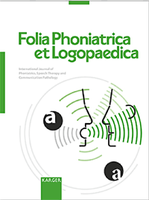GALP Qualifier Scale: Initial Considerations to Classify a Voice Problem. Englert M. Mendoza V. Behlau M. De Bodt M. Folia Phoniatr Logop 2019. doi: 10.1159/000502772
Abstract
Objective: To propose a single qualifier scale for voice problems based on the International Classification of Functioning, Disability, and Health (ICF) that classifies a voice problem considering its multidimensionality.
Method: A multicultural database was analyzed (280 subjects). The analyzed information was: the perceptual judgment of the overall voice quality (G); the acoustic analysis (A) with the Acoustic Voice Quality Index; the laryngeal diagnosis (L) and the patient self-assessment (P) using the Voice Handicap Index. The variables were categorized. A 2-step cluster analysis was performed to define groups with common characteristics.
Results: A 7-point qualifier scale, the GALP, was defined to generally classify levels of voice problems considering 4 dimensions of the voice evaluation. Each level of voice problem, that is, no problem, mild, moderate, severe, or complete voice problem, has its own possible outcome for G, A, L, and P that will change, or not, the overall level of voice problem. The extremes of the scale represent “no problem” at all when all parameters are normal, and “complete problem” when all parameters are altered. The 3 levels in between were defined by the cluster analysis (mild, moderate, and severe problem) and change according to the outcome of each evaluation (G, A, L, and P). Thus, changes in one parameter alone may or not contribute to the change of the level of voice problem. Also, there are 2 categories for cases that do not fit the classification (not specified) and for which some of the variables are missing (not applicable).
Conclusion: The GALP scale was proposed to classify the level of voice problem. This approach considers important dimensions of voice evaluation according to the ICF. It is a potential tool to be used by different professionals, with different assessment procedures, and among different populations, clinicians, and study centers.

